August 30, 2012
Olivia and the Fairy Princess
 Oh, I had my concerns once I’d realized that the new Olivia book was called Olivia and the Fairy Princesses, but I should have had more faith in the brilliance of Ian Falconer. The new Olivia is pure princess-fighting propaganda under the guise of as a very good book. Olivia, the book tells us, is having an identity crisis. She doesn’t understand why all the girls (and even some of the boys!) are so desparate to be princesses. They want to be princess ballerinas at dance class, all the while Olivia is going for something stark and modern. They all dressed up as princesses for Halloween, while Olivia dressed up as a warthog. (“It was very effective.”) Why do all the girls want to be the same thing, Olivia wonders? If everybody is a princess, then how can princessing be special?
Oh, I had my concerns once I’d realized that the new Olivia book was called Olivia and the Fairy Princesses, but I should have had more faith in the brilliance of Ian Falconer. The new Olivia is pure princess-fighting propaganda under the guise of as a very good book. Olivia, the book tells us, is having an identity crisis. She doesn’t understand why all the girls (and even some of the boys!) are so desparate to be princesses. They want to be princess ballerinas at dance class, all the while Olivia is going for something stark and modern. They all dressed up as princesses for Halloween, while Olivia dressed up as a warthog. (“It was very effective.”) Why do all the girls want to be the same thing, Olivia wonders? If everybody is a princess, then how can princessing be special?
The very best thing about this book is that its packaged up in princess pink, and so will no doubt find its way into the very grubby (rhinestone-studded) mitts it’s intended for, as well as into the baseball mitts of the daughters of those of us who’ve been reading Peggy Orenstein, provoking some discussions and inspiring some critical thinking too. The book will also have its detractors who resist a story with such obvious politics whose Eloise-ish narrative is a wink-wink at the grown-ups, and it definitely is possible that I love this book way more than Harriet does.
Than Harriet does so far though. I’ll work on this. So glad to have another weapon (and such a smart one too!) in my princess-fighting arsenal.
August 16, 2012
Mary Poppins and Afternoon Tea
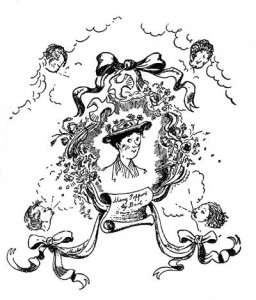 “So, still admiring themselves and each other, they moved on together through the little wood, till presently they came upon a little open space filled with sunlight. And there on a green table was Afternoon-Tea!
“So, still admiring themselves and each other, they moved on together through the little wood, till presently they came upon a little open space filled with sunlight. And there on a green table was Afternoon-Tea!
A pile of raspberry-jam-cakes as high as Mary Poppins’s waist stood in the centre, and beside it tea was boiling in a big brass urn. Best of all, there were two plates of whelks and two pins to pick them out with.
“Strike me pink!” said Mary Poppins. That was what she always said when she was pleased.
“Golly!” said the Match-Man. And that was his particular phrase.
“Won’t you sit down, Moddom?” enquired a voice, and they turned to find a tall man in a black coat coming out of the wood with a table-napkin over his arm.
Mary Poppins, thoroughly surprised, sat down with a plop upon one of the little green chairs that stood round the table. The Match-Man, staring, collapsed on to another.
“I’m the Waiter, you know!” explained the man in the black coat.
“Oh! But I didn’t see you in the picture,” said Mary Poppins.
“Ah, I was behind the tree,” explained the Waiter.
“Won’t you sit down?” said Mary Poppins, politely.
“Waiters never sit down, Moddom,” said the man, but he seemed pleased at being asked.
“Your whelks, Mister!” he said, pushing a plate of them over to the Match-Man. “And your Pin!” He dusted the pin on his napkin and handed it to the Match-Man.
They began upon the afternoon-tea, and the Waiter stood beside them to see they had everything they needed.
“We’re having them after all,” said Mary Poppins in a loud whisper, as she began on the heap of raspberry-jam-cakes.
“Golly!” agreed the Match-Man, helping himself to two of the largest.
“Tea?” said the Waiter, filling a large cup for each of them from the urn.
They drank it and had two cups more each, and then, for luck, they finished the pile of raspberry-jam-cakes. After that they got up and brushed the crumbs off.
“There is Nothing to Pay,” said the Waiter, before they had time to ask for the bill. “It is a Pleasure. You will find the Merry-go-Round just over there!” And he waved his hand to a little gap in the trees, where Mary Poppins and the Match-Man could see several wooden horses whirling round on a stand.
“That’s funny,” said she. “I don’t remember seeing that in the picture, either.”
“Ah,” said the Match-Man, who hadn’t remembered it himself, “it was in the Background, you see!”
The Merry-go-Round was just slowing down as they approached it. They leapt upon it, Mary Poppins on a black horse and the Match-Man on a grey. And when the music started again and they began to move, they rode all the way to Yarmouth and back, because that was the place they both wanted most to see.
When they returned it was nearly dark and the Waiter was watching for them.
“I’m very sorry, Moddom and Mister,” he said politely, “but we close at Seven. Rules, you know. May I show you the Way Out?”
They nodded as he flourished his table-napkin and walked on in front of them through the wood.
“It’s a wonderful picture you’ve drawn this time, Bert,” said Mary Poppins, putting her hand through the Match-Man’s arm and drawing her cloak about her.
“Well, I did my best, Mary,” said the Match-Man modestly. But you could see he was really very pleased with himself indeed.
Just then the Waiter stopped in front of them, beside a large white doorway that looked as though it were made of thick chalk lines.
“Here you are!” he said. “This is the Way Out.”
“Good-bye, and thank you,” said Mary Poppins, shaking his hand.
“Moddom, good-bye!” said the Waiter, bowing so low that his head knocked against his knees.
He nodded to the Match-Man, who cocked his head on one side and closed one eye at the Waiter, which was his way of bidding him farewell. Then Mary Poppins stepped through the white doorway and the Match-Man followed her.”
-From P.L. Travers’ Mary Poppins, which our whole family has been so enjoying for the past week or so.
July 22, 2012
Why You Can Never Have Too Many Mother Gooses
 When Harriet was very small, I read a prescription by Mem Fox, the mother of children’s literacy, that we were to give our children ” at least three stories and five nursery rhymes a day, if not more, and not only at bedtime, either.” And while we were doing just fine in the story department, I realized I really had to pick up the pace in terms of nursery rhymes. As much as nursery rhymes were nonsense, they were also so important to developing literacy skills, in their rhythm and rhyme, and I loved how they connected us back to stories that have been told to children for centuries.
When Harriet was very small, I read a prescription by Mem Fox, the mother of children’s literacy, that we were to give our children ” at least three stories and five nursery rhymes a day, if not more, and not only at bedtime, either.” And while we were doing just fine in the story department, I realized I really had to pick up the pace in terms of nursery rhymes. As much as nursery rhymes were nonsense, they were also so important to developing literacy skills, in their rhythm and rhyme, and I loved how they connected us back to stories that have been told to children for centuries.
 It was around this same time that Mother Goose collections began entering our lives, right when we needed them most. When Harriet was born, my friend Kate had sent us Scott Gustafson’s gorgeously illustrated Favourite Nursery Rhymes from Mother Goose. Not long after, our next door neighbours gave us their old copy of Iona Opie and Rosemary Wells’ My Very First Mother Goose (with characters, we’d realize later, who were Max and Ruby’s forebunnies).
It was around this same time that Mother Goose collections began entering our lives, right when we needed them most. When Harriet was born, my friend Kate had sent us Scott Gustafson’s gorgeously illustrated Favourite Nursery Rhymes from Mother Goose. Not long after, our next door neighbours gave us their old copy of Iona Opie and Rosemary Wells’ My Very First Mother Goose (with characters, we’d realize later, who were Max and Ruby’s forebunnies).
 And so we were chugging along with a Mother Goose in the bedroom and a Mother Goose in the living room, which we thought was probably enough Mother Gooses for one small apartment (with Barbara Reid’s board book Sing a Song of Mother Goose tucked in my purse for days out), until our friends Curtis and Laura gave us Richard Scarry’s Best Mother Goose Ever. Excessive, I know, but we kept this copy in the bedroom too, and we loved Scarry’s cats and rabbits, and his collection’s deliciously violent edge.
And so we were chugging along with a Mother Goose in the bedroom and a Mother Goose in the living room, which we thought was probably enough Mother Gooses for one small apartment (with Barbara Reid’s board book Sing a Song of Mother Goose tucked in my purse for days out), until our friends Curtis and Laura gave us Richard Scarry’s Best Mother Goose Ever. Excessive, I know, but we kept this copy in the bedroom too, and we loved Scarry’s cats and rabbits, and his collection’s deliciously violent edge.
 We picked up a copy of Nursery Rhyme Comics last year, because it was the coolest book we’d ever laid eyes on, and here were all of our favourite rhymes made anew by some of the best comic artists working today. The old woman who lives in the shoe heads a rock band, for example, and it’s the Grand Old Duke of York as imagined by Kate Beaton. We love this book, which isn’t as well thumbed through as all the others because it lives up on the shelf for special (which is often).
We picked up a copy of Nursery Rhyme Comics last year, because it was the coolest book we’d ever laid eyes on, and here were all of our favourite rhymes made anew by some of the best comic artists working today. The old woman who lives in the shoe heads a rock band, for example, and it’s the Grand Old Duke of York as imagined by Kate Beaton. We love this book, which isn’t as well thumbed through as all the others because it lives up on the shelf for special (which is often).
 And so you might suppose that receiving a second-hand copy of The Arnold Lobel Book of Mother Goose last month would have tipped us into too much Mother Goose, finally, but I don’t think so. We’ve chosen to keep this one in the living room, in case you’re wondering, right next to Iona Opie, and I’ve realized that in our excessive Mother Gooses, my entire parenting philosophy is inherent, the things I want to impart to my daughter most.
And so you might suppose that receiving a second-hand copy of The Arnold Lobel Book of Mother Goose last month would have tipped us into too much Mother Goose, finally, but I don’t think so. We’ve chosen to keep this one in the living room, in case you’re wondering, right next to Iona Opie, and I’ve realized that in our excessive Mother Gooses, my entire parenting philosophy is inherent, the things I want to impart to my daughter most.
First, in that one can never have too many books. Second, that there are many, many versions of the same old story, different words entirely to tell it. Sometimes it’s hickory dickory, and sometimes it’s dickory dickory, is what I mean, and you are even free to make it your own. Third, that we are indeed connected to people who lived hundreds of years ago and told these same stories that we do, and some of them might have even made sense then. That we belong to something larger then ourselves. And then finally, as each of these collections is marvellously illustrated, that the same picture never looks the same to anyone. How different, valid and vivid is each of our separate points of view. That all of our favourite stories and characters are imagined over and over again, and we have to be open minded enough both to respect that, and also to recognize them when they appear.
July 18, 2012
Our Best Book of the Library Haul: Big Red Lollipop by Rukhsana Khan and Sophie Blackall
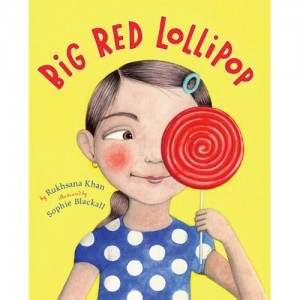 Big Red Lollipop by Rukhsana Khan and Sophie Blackall is the story of a young girl who is eager to fit at school, but who must also conform to her mother’s cultural expectations. When Rubina is invited to a birthday party, her mother sees no reason why her younger sister Sana can’t go too, even though Rubina protests that everyone will think it’s strange her sister comes. And she’s right, they do. When a while later, Sana is invited to a birthday party of her own and is expected to take along their smallest sister, Rubina overcomes the temptation for revenge and steps in to set their mother right
Big Red Lollipop by Rukhsana Khan and Sophie Blackall is the story of a young girl who is eager to fit at school, but who must also conform to her mother’s cultural expectations. When Rubina is invited to a birthday party, her mother sees no reason why her younger sister Sana can’t go too, even though Rubina protests that everyone will think it’s strange her sister comes. And she’s right, they do. When a while later, Sana is invited to a birthday party of her own and is expected to take along their smallest sister, Rubina overcomes the temptation for revenge and steps in to set their mother right
I’ve read this book five times today, at Harriet’s request, and I’m not sure what draws her to it exactly– she’s a bit too young to get it, and I think she’s mostly entranced by the idea of lollipops. And perhaps there is some attraction to the power struggles between the sisters in the book, the squabbling over sharing that she engages in herself with her own friends. I think both of us are also in love with Sophie Blackall’s illustrations, and the fact that two spreads are maps on which we trace our fingers to follow Rubina’s walk home from school, and the sisters’ dash around the furniture.
Big Red Lollipop defies picture book convention in so many ways. Significant time passes in this book, a good year or so. There are clear instances of injustice taking place in the text, no matter how petty, and it’s frustrating to encounter this as a reader. The characters are of an Asian-immigrant background, but the background is not the point of the story. Here is a book in which an Asian-Canadian child can see herself reflected, and in which my daughter can see people who look different than she is–a reflection of the community we live in. In which the parent is both honoured, but also shown as a person who can learn from her children. It is a picture book with the depth of a novel.
July 5, 2012
The Village of Many Hats by Caroline Woodward
 I wanted to read Caroline Woodward’s middle-grade novel The Village of Many Hats because I loved her picture book Singing Away the Dark, and I was curious as to see how her talent would translate. So I was pleased to find that everything I loved about Singing Away… was present here in this story of a small community surrounded by nature in the Kootenays, whose spirit refuses to be permeated by economic hardship, a novel whose heart is a young girl who knows that bravery is not the absence of fear, but instead fear harnessed.
I wanted to read Caroline Woodward’s middle-grade novel The Village of Many Hats because I loved her picture book Singing Away the Dark, and I was curious as to see how her talent would translate. So I was pleased to find that everything I loved about Singing Away… was present here in this story of a small community surrounded by nature in the Kootenays, whose spirit refuses to be permeated by economic hardship, a novel whose heart is a young girl who knows that bravery is not the absence of fear, but instead fear harnessed.
While Gina’s young sister Sara awaits heart surgery at the children’s hospital in Vancouver, Gina tries to keep things together at home and be strong in support of her family. She finds distraction in a part-time job working in a new shop in town whose proprietor is the creator of stunning hats made of recycled materials, which seem to bring strength to their wearers. And when tragedy strikes and the village Hall is damaged in a fire, the residents of Silverado need their hats more than ever.
Woodward has written about the book’s inspiration, and how it also served as a fundraiser for the Reading Centre in New Denver BC. I’m not sure a book itself has ever been able to practice what it preaches, but this one did, underlining my appreciation for this lovely and affirming story of community togetherness.
June 28, 2012
On Barbara Reid's The Party, and devilled eggs, Joan Didion and cousins
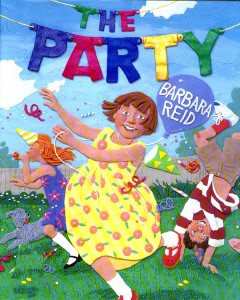 I was born into a family already stocked with aunts and uncles, lots of cousins. And while I was about two decades too late for the party-going as captured in Barbara Reid’s The Party (which has a ’50s/’60s vibe), I can tell you that my grandparents were still hauling around the same cooler, same chairs, bowls full of dip and tins full of squares by the time I came along. I know what it’s like to confront a backyard full of cousin/strangers who are so familiar by day’s end that saying goodbye is a tragedy. And that menu! One day I want to have a The Party party just so that I can serve all the staples: “There’s sausage roles, casseroles, pineapple rings. Devilled eggs, chicken legs, little cheese things. Salads with jelly, salads with beans. Enough? Let the dog lick your party plate clean.”
I was born into a family already stocked with aunts and uncles, lots of cousins. And while I was about two decades too late for the party-going as captured in Barbara Reid’s The Party (which has a ’50s/’60s vibe), I can tell you that my grandparents were still hauling around the same cooler, same chairs, bowls full of dip and tins full of squares by the time I came along. I know what it’s like to confront a backyard full of cousin/strangers who are so familiar by day’s end that saying goodbye is a tragedy. And that menu! One day I want to have a The Party party just so that I can serve all the staples: “There’s sausage roles, casseroles, pineapple rings. Devilled eggs, chicken legs, little cheese things. Salads with jelly, salads with beans. Enough? Let the dog lick your party plate clean.”
It makes me sad that Harriet is unlikely to know the abundance of cousins that I did (and any cousins she might have will live a 5 hour plane journey away from on either side of us), that Barbara Reid’s The Party is a foreign storybook land. Joan Didion’s wrote this about her daughter in “On Going Home”: “I would like to give her more. I would like to promise her that she will grow up with a sense of her cousins and of rivers and of her great-grandmother’s teacups, would like to pledge her a picnic on a river with fried chicken and her hair uncombed, would like to give her home for her birthday, but we live differently now.” And we do.
Though my beloved cousin, who is my oldest friend, has a little girl who is five months younger than Harriet. They see one another just a few times a year, which means they’ve probably met about six times in their lives, but every time, they’ve adored each other and that delights me. That Harriet will know the bonds of cousinship. And then two weekends ago, on the other side of the family, my aunt and uncle invited everybody in the family to spend a sunny afternoon at their farm. These days, we usually only meet at funerals, and the family tree has grown so many branches of its own and with our grandparents gone, it’s hard to get everyone together. But we did, and it was glorious, and Harriet met aunts, uncles and cousins for the very first time, all these people who are a part of who she is, and there was even devilled eggs and bean salads, and a sky that shone like plasticine.
June 26, 2012
Bye Bye Butterflies
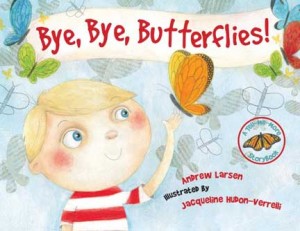 Since the last time we talked about Andrew Larsen, having become big fans of his award-winning book The Imaginary Garden, we’ve also become big fans of Andrew Larsen himself. We live in the same neighbourhood and always delight in seeing him, and so it was a particular joy when a few weeks back, he hand-delivered us a copy of his latest book Bye Bye Butterflies.
Since the last time we talked about Andrew Larsen, having become big fans of his award-winning book The Imaginary Garden, we’ve also become big fans of Andrew Larsen himself. We live in the same neighbourhood and always delight in seeing him, and so it was a particular joy when a few weeks back, he hand-delivered us a copy of his latest book Bye Bye Butterflies.
It’s a story, he told us, that would have particular resonance as Harriet’s gearing up to go to play school in September. Because it’s a story about Septembers, and Junes, and seasons that go round and round, of the things we long to hold onto but have to instead set free in the world. It begins with a little boy called Charlie who’s walking down the street with his dad and in a moment of silence, they hear sounds from the rooftop of a neighbouring school. Shouting children and then, at once, a swarm of butterflies are released into the sky and it’s as though the world is transformed for a little while, then it’s like nothing ever happened.
And Charlie too forgets about this incredible experience, as he starts school himself, as the seasons change and he gets bigger. And then his class begins a new project, raising caterpillars, and eventually, he finds himself on the school rooftop ready to set his butterfly free. “The children felt a little happy and a little sad all at once.” And then the butterflies go, and Charlie peers down to the street and sees another boy gazing up at him and the butterflies, standing just where he’d been with his dad a year before. And so the cycle begins again…
“Our new friends will be with us for just a few days… Then we will have to release them,” says Charlie’s teacher as the butterfly project begins, and of course Larsen’s book is not just about a butterfly’s life cycle only. It’s a story to help young children understand the steps involved in transitioning to big kid, and subtly captures the bittersweet, wonderful-terrible experience of being a parent and having to look on while this transition occurs, as our babies learn to fly away from us.
The idea of happy and sad all at once too is one that struck Harriet as quite profound, and she talked a lot about this after the fact. “Did you know, Mommy,” she said to me, “that something can be happy and sad altogether?” And it’s true that even as adults, we have a hard time getting our heads around this thought, so it was interesting for me to ponder too, and I love how Larsen’s books acknowledge the complexity of the world with such grace and simplicity, rendering these big ideas graspable, the world fixed, if only for a moment.
Check out illustrator Jacqueline Hudon-Verrelli’s blog, with lots of Bye Bye Butterflies in process. Design-wise and visually, the book is wonderful, and I love that it comes stamped with a large warning on its backside: “LIVE CONTENTS. OPEN IMMEDIATELY.” Orders I’d urge any reader to follow fast.
June 20, 2012
Cars Galore!
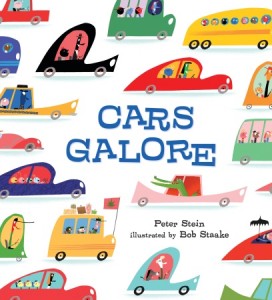 We’ve had Cars Galore by Peter Stein and Bob Staake out of the library for about six weeks now, and it’s starting to look like we’ll have to get a copy of our own. It’s a pretty simple concept, slick retro drawings of automobiles with accompanying rhyming couplets (and how we do love rhyming couplets). Some of the cars are pretty ordinary– fast and slow, on the go, but then the old car is wearing band-aids, which is fascinating if you happen to be three years old, and there’s a fort car, a shark car, and a Noah’s Ark car! “Honk cars! BEEP cars! At-a-creep cars. Miles of piles of in-a-heap cars.”
We’ve had Cars Galore by Peter Stein and Bob Staake out of the library for about six weeks now, and it’s starting to look like we’ll have to get a copy of our own. It’s a pretty simple concept, slick retro drawings of automobiles with accompanying rhyming couplets (and how we do love rhyming couplets). Some of the cars are pretty ordinary– fast and slow, on the go, but then the old car is wearing band-aids, which is fascinating if you happen to be three years old, and there’s a fort car, a shark car, and a Noah’s Ark car! “Honk cars! BEEP cars! At-a-creep cars. Miles of piles of in-a-heap cars.”
We’re a car-loving, road-tripping family, and we’ve never let not owning a car come between us and our love of driving. In fact, it’s probably a big reason for that love because we only get in a car about once a month, and so it’s always a special event when we do. And because we’re Autoshare members, it really has been cars galore around here. Harriet knows more about car brands than the average child from a carless household. We drove the Matrix for a long time, then the Prius, and were getting to be regular drivers of the Mazda 3, when we got a brand new car in our lot. (More about that new car in a sentence or two.) I especially love the “share” in Autoshare, that we get to show Harriet an example of sharing in action (keeping the car tidy, returning it on time, getting excited when we see other Autoshare cars out in the world) as she works hard to learn this vital skill for herself.
 But yes, the car. How we do love “our” Fiat 500, whose awesomeness makes it entirely worth the effort required to get a car-seat into that tiny backseat. It’s red!, sporty, stylish, comfortable, fun to drive, and we like to shout, “Fiat 500!” whenever we’re on the road, to which the rest of the family responds with cheers. Indeed.
But yes, the car. How we do love “our” Fiat 500, whose awesomeness makes it entirely worth the effort required to get a car-seat into that tiny backseat. It’s red!, sporty, stylish, comfortable, fun to drive, and we like to shout, “Fiat 500!” whenever we’re on the road, to which the rest of the family responds with cheers. Indeed.
And we especially like that its radio seems to be playing Carley Rae Jepsen’s Call Me Maybe whenever we want it to be, which is always.
June 18, 2012
Books here and there
 In the latest issue of UofT Magazine, I’ve got a short piece about Katrina Onstad’s new novel Everybody Has Everything:
In the latest issue of UofT Magazine, I’ve got a short piece about Katrina Onstad’s new novel Everybody Has Everything:
“Katrina Onstad ( MA 1999) might be best known for her national newspaper and magazine columns, but her debut novel How Happy to Be was celebrated for its satire, wit, and examination of loving and working in the 21st century. In her new novel, Everybody Has Everything, Onstad takes a similar approach, once again considering the isolating aspects of contemporary urban life. Through her characters James and Ana, she uses the perspective of a longchildless couple to take a provocative look at modern parenthood, illuminating the absurdity of a culture that has turned “parent” into a verb.” (Read the rest)
 And my review of the picture book David Weale and Pierre Pratt’s Doors in the Air, which I loved, has just gone online at Quill & Quire:
And my review of the picture book David Weale and Pierre Pratt’s Doors in the Air, which I loved, has just gone online at Quill & Quire:
“In one of the final illustrations, the boy is perched atop an orange door like a flying carpet, on a journey to the moon. The accompanying text suggests there is no doorway more important than one’s limitless imagination, and drives home the book’s subversive and powerful message: ‘Remember, you don’t have to stay where you are.'” (Read the rest)
June 12, 2012
Great City Picture Books
My love of city picture books continues, and these are some we’ve been enjoying lately, in particular for how they show the modern city in all its international multi-cultural richness.
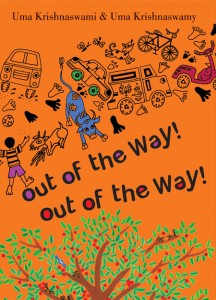 Out of the Way! Out of the Way! by Uma Krishnaswami, illustrated by Uma Krishnaswamy (who are two different people! Really!). This wonderful, colourful book is Silverstein’s The Giving Tree meets Burton’s The Little House, but without the depressing saccharine of the former and the weird ending of the latter. A little tree sprouts in the middle of a path in an Indian town, and as a little boy kneels down to protect it, to admire it, passerbys in a hurry shout: “Out of the way! Out of the way!” The tree grows, the path bends to wind around it, and people come to sit under its branches, birds nest in the leaves, and a city grows up too around them as the path is steamrolled into a road whose traffic includes bicycles with dinging bells, bullock carts, and mango sellers shouting, “Out of the way! Out of the way!” The book gets bonus points for including fabulous pictures of the cars and trucks that crowd the streets, guaranteed to delight small readers (even a cement mixer!), and also for leaving the tree standing, a place for quiet and contemplation in the middle of the bustling city space.
Out of the Way! Out of the Way! by Uma Krishnaswami, illustrated by Uma Krishnaswamy (who are two different people! Really!). This wonderful, colourful book is Silverstein’s The Giving Tree meets Burton’s The Little House, but without the depressing saccharine of the former and the weird ending of the latter. A little tree sprouts in the middle of a path in an Indian town, and as a little boy kneels down to protect it, to admire it, passerbys in a hurry shout: “Out of the way! Out of the way!” The tree grows, the path bends to wind around it, and people come to sit under its branches, birds nest in the leaves, and a city grows up too around them as the path is steamrolled into a road whose traffic includes bicycles with dinging bells, bullock carts, and mango sellers shouting, “Out of the way! Out of the way!” The book gets bonus points for including fabulous pictures of the cars and trucks that crowd the streets, guaranteed to delight small readers (even a cement mixer!), and also for leaving the tree standing, a place for quiet and contemplation in the middle of the bustling city space.
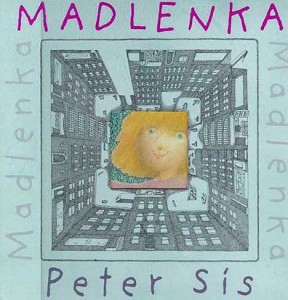 Madelenka by Peter Sis: Not a new book, but new to us, about a little girl who lives “in the universe, on a planet, on a continent, in a country, in a city, on a block, in a house, in a window, ” and she is Madlenka and her tooth is loose. Sis’s drawings give us a bird’s eye view of the block as Madlenka goes through the neighbourhood sharing her news. Each of the shopkeepers she encounters comes from a different place– the baker from France, the newsagent from India, the Italian ice-cream man, the German neighbour Mrs. Grimm who knows so many stories. In some cases, we’re granted a tour of the shops in questions, and also a visual representation of the stories Madlenka has told to her: the South American grocer’s jaguar legends, her Asian neighbours stories of dragons, and even the fantasy world that she’s invented with her school friend Cleopatra which transforms their courtyard into the African savanna. The tooth gets lost and Madlenka goes home to report that in connecting with her neighbours she has been around the world. (You can take a virtual tour of the book on Peter Sis’s website).
Madelenka by Peter Sis: Not a new book, but new to us, about a little girl who lives “in the universe, on a planet, on a continent, in a country, in a city, on a block, in a house, in a window, ” and she is Madlenka and her tooth is loose. Sis’s drawings give us a bird’s eye view of the block as Madlenka goes through the neighbourhood sharing her news. Each of the shopkeepers she encounters comes from a different place– the baker from France, the newsagent from India, the Italian ice-cream man, the German neighbour Mrs. Grimm who knows so many stories. In some cases, we’re granted a tour of the shops in questions, and also a visual representation of the stories Madlenka has told to her: the South American grocer’s jaguar legends, her Asian neighbours stories of dragons, and even the fantasy world that she’s invented with her school friend Cleopatra which transforms their courtyard into the African savanna. The tooth gets lost and Madlenka goes home to report that in connecting with her neighbours she has been around the world. (You can take a virtual tour of the book on Peter Sis’s website).
 A Bus Called Heaven by Bob Graham: We love Bob Graham and his heartwarming stories of community in urban places (though they’re often more inner-suburban, run-down homes, shuttered shops and factories next to grassy yards). His books are also just a little bit strange, poetic and surprising. They’re edgy in the softest way, and Harriet is entranced with this latest one, the story of an abandoned bus that transforms a city street. With no idea where the bus arrived from, neighbours haul it off the road and into Stella’s driveway. Shy Stella is transformed herself as the bus is turned into a community hub, everybody doing their part to make it beautiful. Now there is a place for people to gather and connect, Graham’s illustrations showing neighbours of all different cultures and backgrounds together. And when regulations about busses protruding into the sidewalk threaten to spoil the show, it is Stella who saves the day (and the snails. And the sparrows). We love this book.
A Bus Called Heaven by Bob Graham: We love Bob Graham and his heartwarming stories of community in urban places (though they’re often more inner-suburban, run-down homes, shuttered shops and factories next to grassy yards). His books are also just a little bit strange, poetic and surprising. They’re edgy in the softest way, and Harriet is entranced with this latest one, the story of an abandoned bus that transforms a city street. With no idea where the bus arrived from, neighbours haul it off the road and into Stella’s driveway. Shy Stella is transformed herself as the bus is turned into a community hub, everybody doing their part to make it beautiful. Now there is a place for people to gather and connect, Graham’s illustrations showing neighbours of all different cultures and backgrounds together. And when regulations about busses protruding into the sidewalk threaten to spoil the show, it is Stella who saves the day (and the snails. And the sparrows). We love this book.





